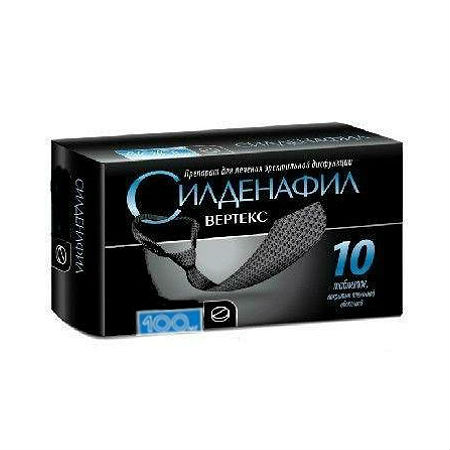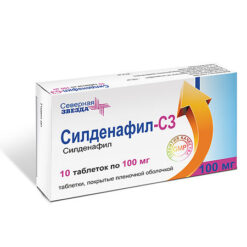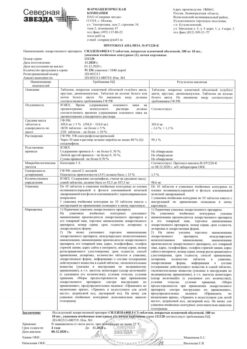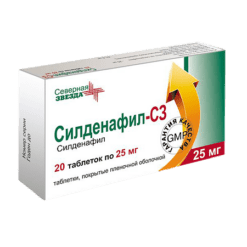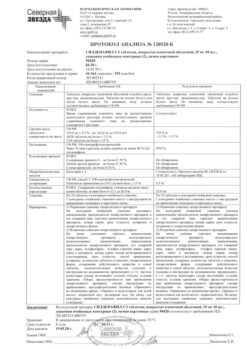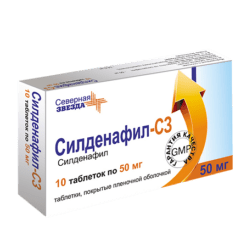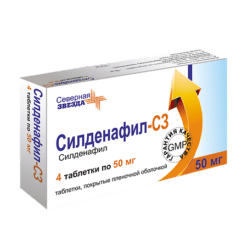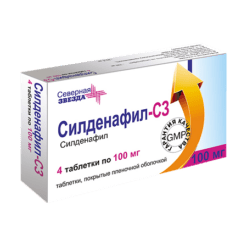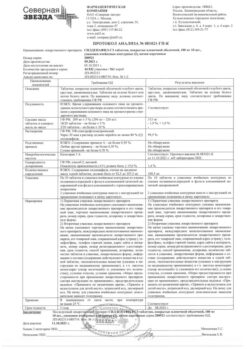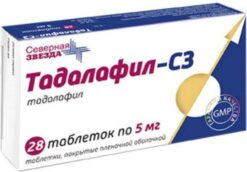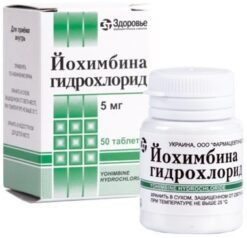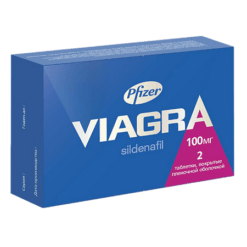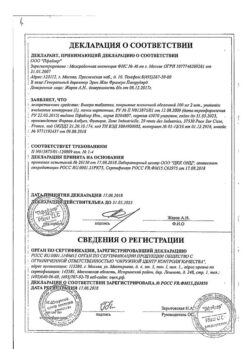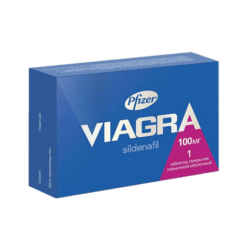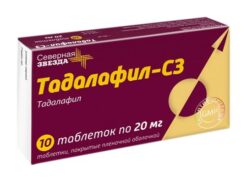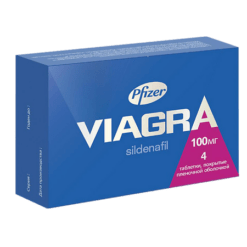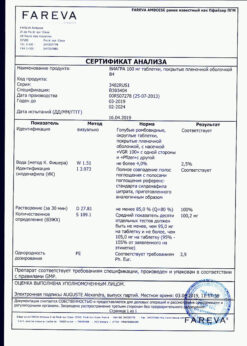No products in the cart.
Sildenafil Vertex, 100 mg 10 pcs
€1.00
Out of stock
(E-mail when Stock is available)
Description
ATC code: G04BE03
Pharmacological properties
Pharmacodynamics
br> Sildenafil is a potent selective inhibitor of cycloguanosine monophosphate (cGMP)-specific phosphodiesterase type 5 (PDE5). It restores impaired erectile function by increasing blood flow to the penis.
Realization of the physiological mechanism of erection is connected to the release of nitric oxide (NO) in the cavernous body during sexual stimulation. This, in turn, leads to an increase in the level of cGMP, the subsequent relaxation of the smooth muscle tissue of the cavernous body and an increase in blood flow.
Sildenafil does not have a direct relaxing effect on the isolated human cavernous body, but it enhances the effect of nitric oxide (NO) by inhibiting FDE5, which is responsible for the breakdown of cGMP.
When the NO/ cGMF bond is activated by sexual stimuli, inhibition of FDE5 by sildenafil leads to an increase of cGMF in the cavernous body. Thus, sexual stimulation is necessary for the development of the desired pharmacological action of sildenafil.
Sildenafil is selective against FDE5 in vitro, its activity against FDE5 is superior to activity against other known phosphodiesterase isoenzymes:
FDE6, 10 times; FDE1, more than 80 times; FDE2, FDE4, FDE7-FDE11, more than 700 times. Sildenafil is 4,000 times more selective against FDE5 compared to FDE3, which is very important because FDE3 is one of the key enzymes regulating myocardial contractility.
Sildenafil causes a small and transient decrease in blood pressure (BP), which in most cases has no clinical manifestations. The mean maximum decrease in systolic BP in the supine position, after taking sildenafil orally at a dose of 100 mg is 8.3 mm Hg. The corresponding change in diastolic BP is 5.3 mm Hg. A single oral sildenafil dose of 100 mg was not associated with clinically significant electrocardiogram (ECG) changes in healthy volunteers. Sildenafil has no effect on cardiac output and does not alter blood flow through stenosed arteries. A more pronounced but also transient effect on BP was noted in patients taking nitrates.
In some patients, 1 hour after taking sildenafil at a dose of 100 mg, the Farnsworth-Munsel 100 test revealed a mild and transient impairment in the ability to distinguish shades of color (blue/green). These changes were absent 2 hours after taking the drug. The color vision impairment is thought to be caused by inhibition of FDE6, which is involved in the transmission of light in the retina. Sildenafil has no effect on visual acuity, contrast perception, electroretinogram, intraocular pressure, or pupil diameter.
Pharmacokinetics
The pharmacokinetics of sildenafil in the recommended dose range is linear.
Intake
Sildenafil is rapidly absorbed after oral administration. Absolute bioavailability averages about 40% (25% to 63%). In vitro sildenafil at a concentration of about 1.7 ng/ml (3.5 nM) inhibits human FDE5 activity by 50%. After a single sildenafil dose of 100 mg, the average maximum plasma concentration (Cmax) of free sildenafil in men is about 18 ng/ml (38 nM). Cmax when sildenafil is taken orally on an empty stomach is reached on average within 60 min (30 min to 120 min). When taken in combination with fatty food the absorption rate decreases: Cmax decreases on average by
29 %, and time to maximum concentration (Tmax) increases by 60 min, but absorption degree does not change significantly (area under the pharmacokinetic curve of concentration-time (AUC) decreases by 11 %).
Distribution
Distribution volume of sildenafil in the equilibrium state is on average 105 liters.
Binding of sildenafil and its main circulating N-demethyl metabolite with blood plasma proteins is about 96 % and is independent of the total drug concentration. Less than 0.0002% of the sildenafil dose (188 ng on average) is detected in semen 90 min after taking the drug.
Metabolism
Sildenafil is metabolized primarily in the liver by the cytochrome isoenzyme CYP3A4 (main route) and the cytochrome isoenzyme CYP2C9 (additional route). The main circulating active metabolite formed as a result of
N-demethylation of sildenafil undergoes further metabolism. Selectivity of this metabolite against FDE is comparable with that of sildenafil, and its activity against FDE5 in vitro is about 50% of sildenafil activity. Concentration of the metabolite in blood plasma of healthy volunteers was about 40% of sildenafil concentration. N-demethyl metabolite is further metabolized; its half-life (T1/2) is about 4 hours.
Elimination
Total clearance of sildenafil is 41 l/hour and the final T1/2 is 3-5 hours. After oral administration sildenafil is excreted as metabolites, mainly by the intestine (about 80% of the dose) and to a lesser extent by the kidneys (about 13% of the dose).
Pharmacokinetics in special patient groups
Elderly patients
Healthy elderly patients (over 65 years of age) have reduced sildenafil clearance and plasma free sildenafil concentrations are about 40% higher than those of younger patients (18-45 years of age). Age has no clinically significant effect on the incidence of side effects.
Patients with impaired renal function
In mild (creatinine clearance (CK) 50-80 ml/min) and moderate (CK 30-49 ml/min) renal impairment, the pharmacokinetics of sildenafil after a single oral dose of 50 mg is unchanged. In severe renal failure (CK≤ 30 ml/min), sildenafil clearance is decreased, resulting in approximately twofold increase of AUC (100%) and Cmax (88%) compared to normal renal function in patients of the same age group.
Patients with hepatic impairment
In patients with cirrhosis (Child-Pugh stages A and B), sildenafil clearance is decreased, resulting in increased AUC (84%) and Cmax (47%) compared to normal hepatic function in patients in the same age group. Pharmacokinetics of sildenafil in patients with severe hepatic impairment (Child-Pugh stage C) has not been studied.
Indications
Indications
Treatment of erectile dysfunction characterized by the inability to achieve or maintain a penile erection sufficient for satisfactory intercourse. Effective only with sexual stimulation.
Active ingredient
Active ingredient
Composition
Composition
Active substance:
sildenafil citrate (in terms of sildenafil) – 100.00 mg;
excipients:
Lactose monohydrate – 291.55 mg,
Microcrystalline cellulose – 120.00 mg,
How to take, the dosage
How to take, the dosage
Ingestion.
The recommended dose for most adult patients is 50 mg approximately 1 hour before sexual activity.
The dose may be increased to 100 mg or decreased to 25 mg, depending on efficacy and tolerability. The maximum recommended dose is 100 mg. The maximum recommended frequency of use is once a day.
In mild to moderate renal insufficiency (CK 30-80 ml/min), no dose adjustment is required; in severe renal insufficiency (CK < 30 ml/min) the sildenafil dose should be reduced to 25 mg.
Because sildenafil excretion is impaired in patients with liver damage
(particularly in cirrhosis), the sildenafil dose should be reduced to 25 mg.
There is no need to adjust the sildenafil dose in elderly patients.
In co-administration with cytochrome CYP3A4 isoenzyme inhibitors (erythromycin, saquinavir, ketoconazole, itraconazole) the starting dose of sildenafil should be 25 mg (see section “Interaction with other medicinal products”).
In order to minimize the risk of postural hypotension in patients taking alpha-adrenoblockers, sildenafil should not be started until hemodynamic stabilization has been achieved in these patients. The initial dose of sildenafil is 25 mg
(see sections “Special Precautions” and “Interaction with other medicinal products”).
Interaction
Interaction
Influence of other drugs on sildenafil pharmacokinetics
The metabolism of sildenafil occurs mainly in the liver under the action of cytochrome CYP3A4 isoenzymes (main route) and CYP2C9, therefore inhibitors of these isoenzymes may decrease sildenafil clearance, and inducers, respectively, increase sildenafil clearance. There is a decrease in sildenafil clearance when concomitant use of inhibitors of CYP3A4 cytochrome isoenzyme (ketoconazole, erythromycin, cimetidine). Cimetidine (800 mg), a non-specific inhibitor of cytochrome CYP3A4 isoenzyme, when combined with sildenafil (50 mg) causes an increase in plasma concentration of sildenafil by 56 %.
The single use of 100 mg sildenafil together with erythromycin (500 mg/day 2 times
a day for 5 days), a specific inhibitor of cytochrome CYP3A4 isoenzyme, on achieving a constant concentration of erythromycin in blood, leads to increase of AUC of sildenafil by 182 %.
When taking sildenafil (100 mg once) and saquinavir (1200 mg/day 3 times
a day), an HIV protease inhibitor and cytochrome CYP3A4 isoenzyme, together against achieving a constant concentration of saquinavir in the blood Cmax of sildenafil was increased by 140 % and AUC was increased by 210 %. Sildenafil has no effect on the pharmacokinetics of saquinavir. Stronger inhibitors of cytochrome CYP3A4 isoenzyme, such as ketoconazole and itraconazole, can cause stronger changes in the pharmacokinetics of sildenafil.
The simultaneous use of sildenafil (100 mg once) and ritonavir (500 mg twice
daily), an HIV protease inhibitor and a strong cytochrome P450 inhibitor, against the background of achieving a constant concentration of ritonavir in blood leads to an increase in Cmax of sildenafil by 300% (4 times) and AUC by 1000% (11 times). After 24 hours the plasma concentration of sildenafil is about 200 ng/ml (after a single use of sildenafil – 5 ng/ml).
Grapefruit juice, a weak CYP3A4 inhibitor, can moderately increase plasma concentrations of sildenafil.
If sildenafil is taken at recommended doses in patients receiving concomitant strong CYP3A4 cytochrome isoenzyme inhibitors, the Cmax of free sildenafil does not exceed 200 nM and the drug is well tolerated.
A single intake of antacid (magnesium hydroxide/aluminum hydroxide) does not affect the bioavailability of sildenafil.
CYP2C9 cytochrome isoenzyme inhibitors (such as tolbutamide, warfarin), CYP2D6 cytochrome isoenzyme inhibitors (such as selective serotonin reuptake inhibitors, tricyclic antidepressants), Thiazide and thiazide-like diuretics, ACE (angiotensin converting enzyme) inhibitors and calcium antagonists have no effect on the pharmacokinetic parameters of sildenafil.
Azithromycin (500 mg/day for 3 days) has no effect on AUC, Cmax, Tmax, elimination rate constant and T1/2 of sildenafil or its main circulating metabolite.
Nicorandil is a hybrid of a nitrate and potassium channel activator. Because of its nitrate component, it can have serious interactions with sildenafil.
The effect of sildenafil on other drugs
Sildenafil is a weak inhibitor of cytochrome P450 system isoenzymes – 1A2, 2C9, 2C19, 2D6, 2E1 and 3A4 (IK50>150 μmol). When taking sildenafil at the recommended doses, its Cmax is about 1 μmol, so it is unlikely that sildenafil can affect the clearance of substrates of these isoenzymes.
Sildenafil enhances the hypotensive effect of nitrates both with long-term use of the latter and when prescribed for acute indications. Therefore, the use of sildenafil in combination with nitrates or nitric oxide donors is contraindicated.
The concomitant use of the adrenal alpha blocker doxazosin (4 mg and 8 mg) and sildenafil (25 mg, 50 mg and 100 mg) in patients with benign prostatic hyperplasia with stable hemodynamics had a mean additional decrease of systolic/diastolic BP in the supine position of 7/7 mmHg. Hg, 9/5 mmHg and
8/4 mmHg, respectively, and 6/6 mmHg, 11/4 mmHg, and
4/5 mmHg in the standing position, respectively. Rare cases of symptomatic postural hypotension, manifested as dizziness (without fainting), have been reported in these patients. In some sensitive patients receiving alpha-adrenoblockers, concomitant use of sildenafil may lead to symptomatic hypotension.
There are no indications of significant interaction of sildenafil (50 mg) with tolbutamide (250 mg) or warfarin (40 mg), which are metabolized by cytochrome CYP2C9 isoenzyme.
Sildenafil (100 mg) has no effect on the pharmacokinetics of HIV protease inhibitors, saquinavir and ritonavir, which are substrates of cytochrome CYP3A4 isoenzyme, when their blood levels are constant.
Sildenafil (50 mg) does not cause an additional increase in bleeding time when taking acetylsalicylic acid (150 mg).
Sildenafil (50 mg) does not increase the hypotensive effects of ethanol in healthy volunteers at a maximum blood ethanol concentration of 0.08% (80 mg/dL) on average.
In patients with arterial hypertension there is no evidence of interaction of sildenafil (100 mg) with amlodipine. The mean additional reduction of BP in the supine position is 8 mmHg (systolic) and 7 mmHg (diastolic).
The use of sildenafil in combination with hypotensive agents does not lead to additional side effects.
Special Instructions
Special Instructions
To diagnose erectile dysfunction, determine its possible causes, and choose an adequate treatment, a complete medical history and a thorough physical examination must be taken. Erectile dysfunction medications should be used with caution in patients with anatomical penile deformities (penile angulation, cavernous fibrosis, Peyronie’s disease) or in patients with risk factors for priapism (sickle cell anemia, multiple myeloma, leukemia).
Drugs intended to treat erectile dysfunction should not be prescribed for men for whom sexual activity is undesirable.
Sexual activity poses a certain risk in the presence of heart disease, so before starting any therapy for erectile dysfunction, the doctor should refer the patient for an examination of the cardiovascular system. Sildenafil use is contraindicated in patients with heart failure, unstable angina pectoris, myocardial infarction or stroke during the last six months, hypotension (BP < 90/50 mm Hg). Clinical studies have shown no difference in the incidence of myocardial infarction (1.1 per 100 people per year) or cardiovascular mortality rate (0.3 per 100 people per year) in patients receiving sildenafil compared to patients receiving placebo.
Cardiovascular Complications
In the postmarketing use of sildenafil for the treatment of erectile dysfunction, adverse events such as serious cardiovascular complications (including myocardial infarction, unstable angina, sudden cardiac death, ventricular arrhythmias, hemorrhagic stroke, transient ischemic attack, hypertension, and hypotension) that were temporarily associated with sildenafil use. Most, but not all, of these patients had risk factors for cardiovascular complications. Many of these adverse events were observed shortly after sexual activity and some were noted after sildenafil administration without subsequent sexual activity. It is not possible to establish a direct relationship between the reported adverse events and these or other factors.
Hypotension
Sildenafil has a systemic vasodilatory effect resulting in a transient decrease in BP, which is not clinically significant and has no effect in most patients. Nevertheless, before prescribing sildenafil, the physician should carefully assess the risk of possible adverse vasodilatory effects in patients with relevant diseases, especially against the background of sexual activity. Increased susceptibility to vasodilators is observed in patients with left ventricular outflow tract obstruction (aortic stenosis, hypertrophic obstructive cardiomyopathy), as well as with the rare syndrome of multiple systemic atrophy manifested by severe BP regulation disorder of the autonomic nervous system.
Since co-administration of sildenafil and alpha-adrenoblockers may lead to symptomatic hypotension in some sensitive patients, sildenafil should be prescribed with caution in patients taking alpha-adrenoblockers (see section “Interaction with other medicinal products”). In order to minimize the risk of postural hypotension in patients taking alpha-adrenoblockers, sildenafil should be started only after hemodynamic stabilization in these patients is achieved. It should also be considered to reduce the initial dose of sildenafil (see section “Dosage and administration”). The physician should inform the patient about what actions should be taken in case symptoms of postural hypotension occur.
Some postmarketing and clinical studies have reported cases of sudden deterioration or hearing loss associated with the use of all FDE5 inhibitors, including sildenafil. However, in most cases, these patients had risk factors for the development of this pathology. A causal relationship between the use of FDE5 inhibitors and sudden hearing impairment or hearing loss has not been established. The patient should be warned that if there is a sudden hearing loss or sudden hearing loss, sildenafil therapy should be discontinued and the patient should immediately consult a physician.
Sildenafil enhances the antiplatelet effect of sodium nitroprusside (nitric oxide donor) on human platelets in vitro. There are no data on the safety of sildenafil administration in patients with a tendency to bleeding or exacerbation of gastric and
12 duodenal ulcer, so sildenafil should be used with caution in these patients (see section “Caution”).
The safety and effectiveness of sildenafil combined with other erectile dysfunction treatments have not been studied, so the use of such combinations is not recommended.
Influence on driving and operating ability
Since sildenafil administration may cause decreased BP, development of chromatopsia, blurred vision, and other side effects, careful consideration should be given to the individual effect of the drug in the above situations, especially at the beginning of treatment and when changing the dosing regimen.
Contraindications
Contraindications
Side effects
Side effects
Classification of the frequency of side effects (WHO):
very frequently >1/10;
frequently from >1/100 to <1/10;
infrequently from >1/1000 to <1/100;
rarely from >1/10000 to < 1/1000;
very rarely <1/10000, including individual reports;
frequency is unknown: No frequency of occurrence can be ascertained from available data.
Nervous system disorders:
very common – headache;
frequent – dizziness;
infrequent – somnolence, hypoesthesia;
rare – cerebrovascular events, fainting;
frequency unknown – transient ischemic attack, seizures, including recurrent.
Visually impaired:
frequent – visual disturbances, transient color perception disorders (chromatopsia);
infrequent – conjunctival lesions, tear production disorders;
frequency unknown – anterior ischemic optical neuropathy of non-arterial genesis, retinal vascular occlusion, visual field defects.
Hearing organ:
infrequent – dizziness, tinnitus;
rarely – deafness.
Cardiovascular system disorders:
often – blood rush to the skin of the face;
infrequently – palpitations, tachycardia;
rarely – increase or decrease in blood pressure, myocardial infarction, atrial fibrillation;
frequency unknown – ventricular arrhythmia, unstable angina pectoris, sudden cardiac arrest.
Respiratory system disorders:
often – nasal congestion;
rarely – nasal bleeding.
Gastrointestinal tract:
often – dyspepsia;
infrequently – vomiting, nausea, dryness of the oral mucosa.
Allergic reactions:
infrequent – skin rash;
frequency unknown – Stevens-Johnson syndrome, toxic epidermal necrolysis (Lyell’s syndrome).
Musculoskeletal system:
infrequent – myalgia.
Genital organs:
infrequent – hematospermia, bleeding from the penis;
frequency unknown – priapism, prolonged erection.
Other:
infrequent – chest pain, increased fatigue.
Overdose
Overdose
Symptoms: headache, blood rushes to the face, dizziness, dyspepsia, nasal congestion, visual disturbances.
When taking sildenafil at a single dose of up to 800 mg, the adverse events were comparable to those when taking the drug at lower doses, but occurred more frequently.
Treatment: symptomatic. Hemodialysis does not accelerate clearance of sildenafil, because the latter is actively bound to plasma proteins and is not excreted by the kidneys.
Similarities
Similarities
Additional information
| Manufacturer | Vertex, Russia |
|---|---|
| Medication form | pills |
| Brand | Vertex |
Other forms…
Related products
Buy Sildenafil Vertex, 100 mg 10 pcs with delivery to USA, UK, Europe and over 120 other countries.

